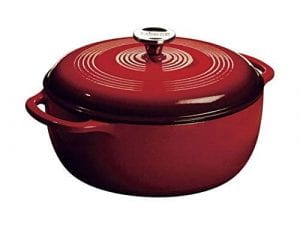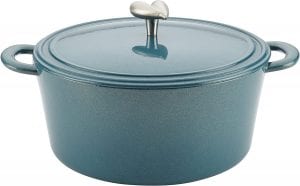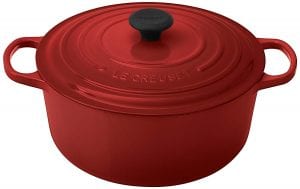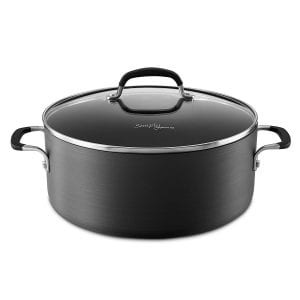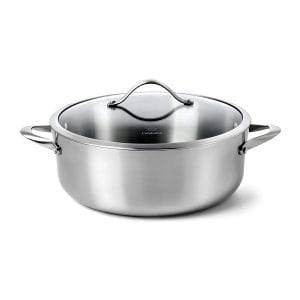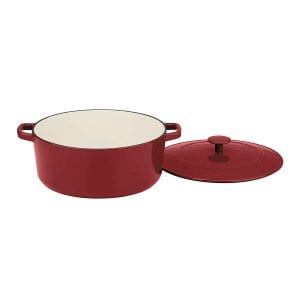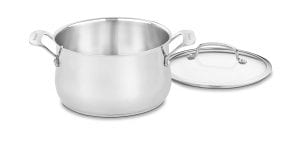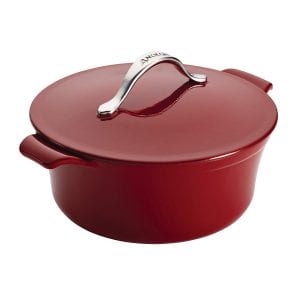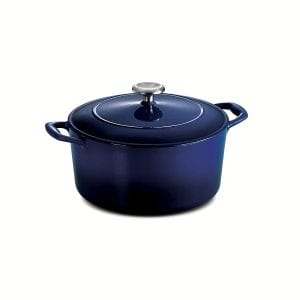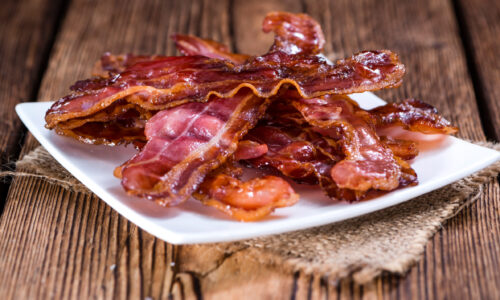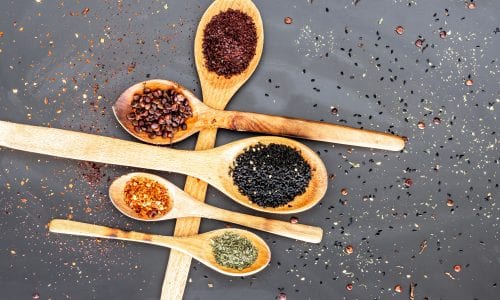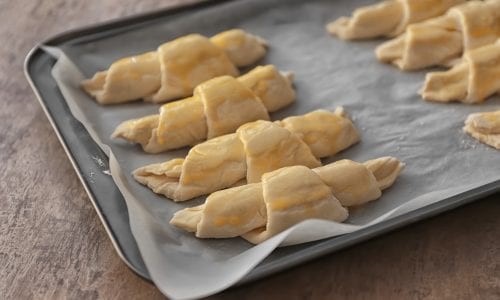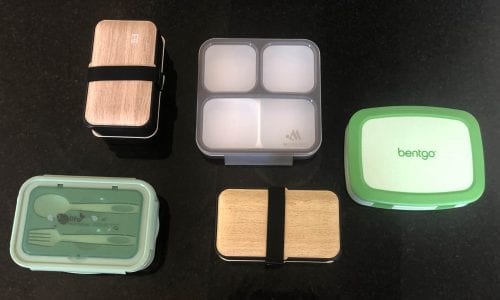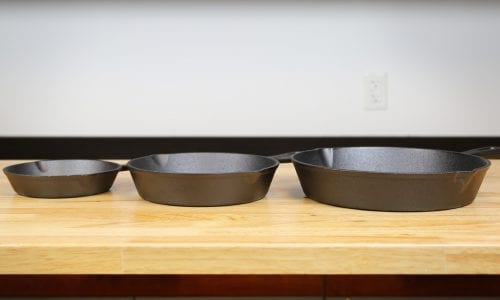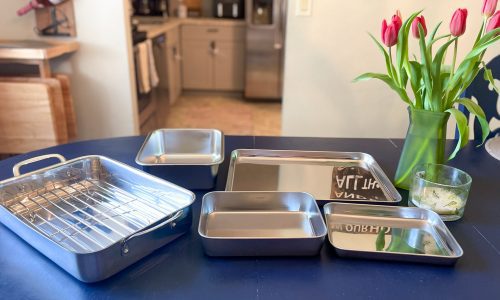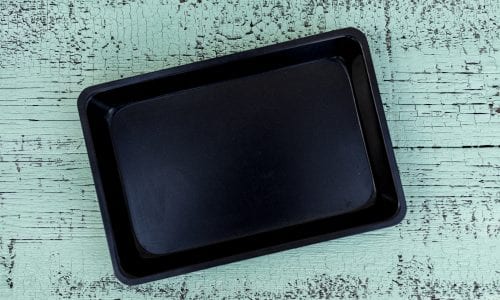The Best Dutch Oven
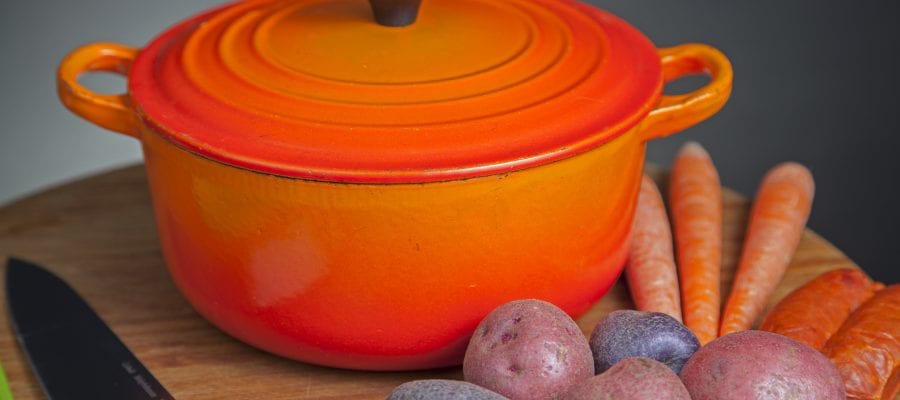
Our Review Process
Don't Waste Your Money is focused on helping you make the best purchasing decision. Our team of experts spends hundreds of hours analyzing, testing, and researching products so you don't have to. Learn more.
Our Picks For The Top Dutch Ovens
- 1. Lodge Enameled Cast Iron Dutch Oven
- 2. Ayesha Curry 6-Quart Twilight Teal Cast Iron Enamel Dutch Oven
- 3. Le Creuset Signature Enameled Cast-Iron Dutch Oven
- 4. Simply Calphalon Nonstick Dutch Oven
- 5. Calphalon Contemporary Stainless Steel Dutch Oven
- 6. Cuisinart Chef’s Classic Enameled Cast Iron Dutch Oven
- 7. Cuisinart Contour Stainless Steel Dutch Oven
- 8. Anolon Vesta Cast Iron Dutch Oven
- 9. Tramontina Enameled Cast Iron Dutch Oven
The glossy finish and curved sides of this Lodge Enameled Cast Iron Dutch Oven get major style points from us — but they also have practical functions. The enameled cast iron inside and out makes this easy to clean and long-lasting. The curved edges make it nearly impossible for food to get stuck and caked on in the corners while cooking, which w...
Fantastic Value, Easier To CleanWell-designed dutch oven enameled inside and out for easy cleaning. Excellent value.
You can make a variety of meals in this durable Dutch oven, which is oven safe up to 500 degrees Fahrenheit. It has oven-to-table versatility thanks to the stylish exterior and functional interior. Plus, the handles and knob are large enough to hold while wearing oven mitts.
Oven Safe Up to 500 Degrees Fahrenheit This versatile and stylish pot is perfect for stovetop and oven cooking.
While the Le Creuset Signature Enameled Cast Iron Dutch Oven is somewhat of a pricey investment, the range of colors and the durability of this product line make it worth it in the end. You can choose from all sorts of colors so this will be a standout in your kitchen. We like that this version is enameled inside and out for easier cleaning, and do...
The Gold StandardEnameled interior for easier cleaning. Top-quality product you will own for life.
The Simply Calphalon Nonstick Dutch Oven is easy to cook, clean and care for. Our testers appreciated how much lighter this is compared to cast iron models. You can maneuver around the kitchen much easier with this dutch oven. If you're looking for something that's lightweight, requires little maintenance, but will still help you make delicious me...
Light and EasyA light, dependable non-stick dutch oven at a good price. Easy to use, clean and put away.
Buying Guide
Dutch ovens could change the way you prepare meals for the better. The convenience of being able to easily place a Dutch oven from the stovetop directly into the oven means less transferring of meals from skillets to casserole dishes and therefore, less clean-up for you in the end.
Models from brands such as Lodge and Le Creuset offer enameled cast iron versions that will stand the test of time. You’ll worry less about chipping, etc., but the maintenance on the enameled cast iron is a little more involved. However, if you’re willing to put in the upkeep, these will last you a lifetime.
There’s also a highly rated non-stick version from Simply Calphalon that you may feel more comfortable with, especially if you’re already used to cooking on non-stick skillets, etc. While you may notice more chipping on a non-stick surface, if handled with care, this type of Dutch oven will be a part of your kitchen for a good while.
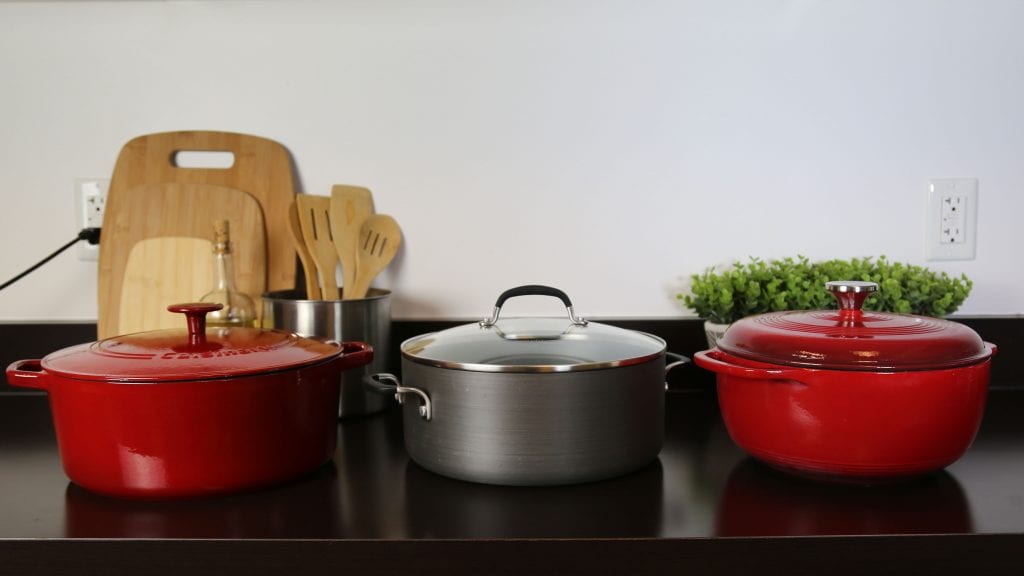
Whether you’re choosing enameled cast iron or non-stick is just one of the considerations that goes into purchasing a Dutch oven. You’ll also need to think about the size of the Dutch oven you’ll need, what type of handles you’ll want to work with and more. But, that’s where the reviews for the top-rated Dutch ovens come in handy. Because the smallest details can make a big difference when you’re dealing with hot foods and surfaces in your kitchen!
From sloped interiors to the type of material the handles are made of, no detail was overlooked when putting these products to the test. So, you’ll have an easier time deciding which products will work the best in your kitchen, and once you have — you’ll be well on your way to cooking up pot roasts and more delicious meals in brand-spankin’ new Dutch oven.
What to Look For
- You’ll need to consider the size of Dutch oven you’ll need. Thinking about the types of dishes you’ll be preparing, how many people you typically feed, etc., will help you decide how many quarts a dutch oven should be able to hold to meet your needs.
- The material the Dutch oven is made out of will be a crucial factor, too. While an enamel-covered cast iron dutch oven will hold up well over time, it can also be more difficult to clean and care for — especially once it starts to show signs of areas that have been burned over time. Non-stick options are also available, and while these may chip before their enamel-covered cast iron counterparts, they’re a bit easier to maintain. So, you’ll have to consider what matters more: easy clean-up vs. indestructibility.
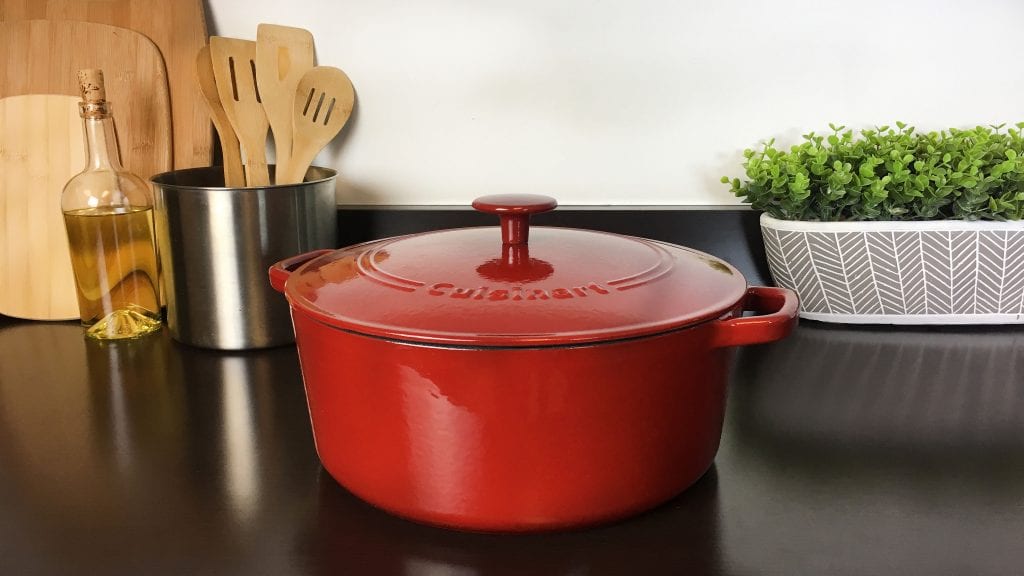
- Keep in mind, if you go with an enamel-covered cast iron option, you’re in for easier clean up than a plain old cast iron version. Good thing that several of the highly rated options provided in this list are enameled cast iron, which does not need to be seasoned before using in the way that cast iron does. Phew!
- A detail you wouldn’t necessarily think about when making a purchase — the size and shape of the handles — is actually a very important part of choosing a Dutch oven. Selecting a Dutch oven with wide handles can make getting a heavy Dutch oven out of the oven easier, which will be a game changer when you’re cooking. The type of material the handle is made out of also matters. For example, a knock against the Simply Calphalon version is that the stainless steel handles can get extremely hot, so you’ll always want to handle with caution.
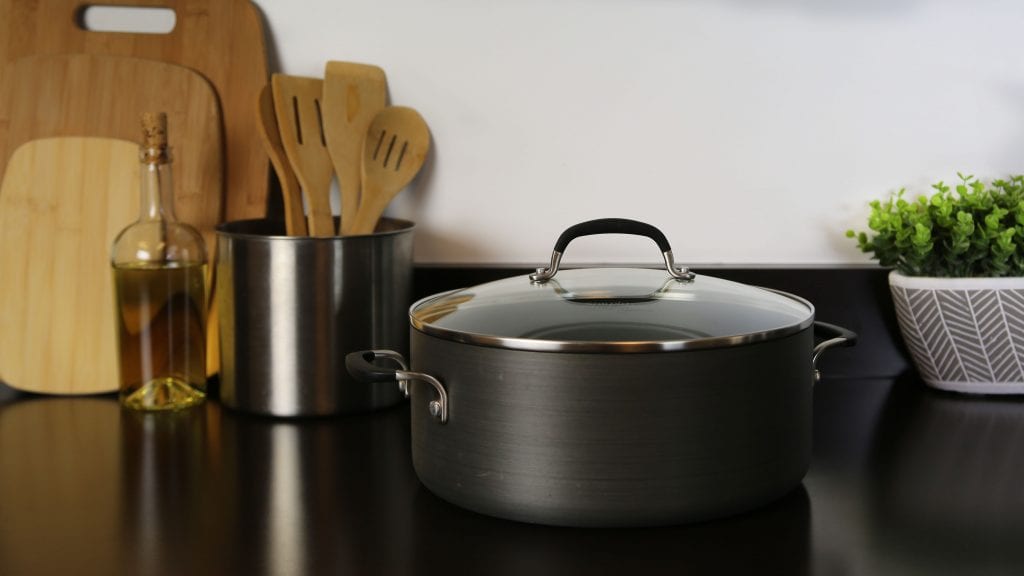
- The shape of a Dutch oven can come into play when it’s time to clean. A round Dutch oven vs. a rectangular Dutch oven, for example, is easier to clean, considering the food can’t get caught and stuck in any hard to reach places.
- Surprisingly, a Dutch oven can get quite heavy, so you’ll want to check to see how much the version you’re thinking of buying weighs before ultimately making a purchase. The highly-rated version from Lodge, for example, weighs 14 pounds. So, if you think you’d have a difficult time maneuvering this in your kitchen, you may want to look for a lighter option.
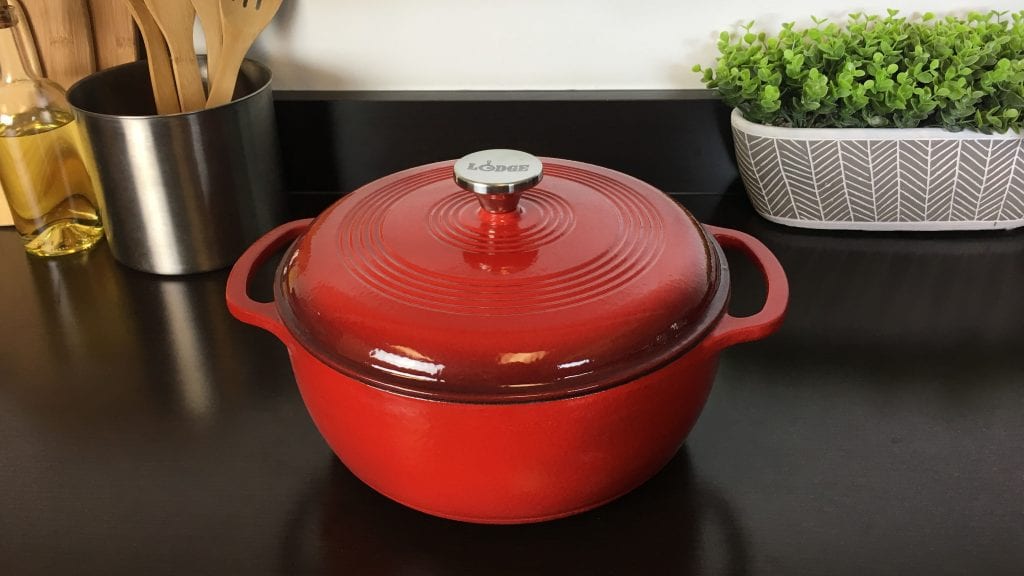
More to Explore
Ever wonder how Dutch ovens came to be called “Dutch ovens?”
Well, apparently, it was the Dutch who invented a new way of casting metals back in the 17th century.
The new mold used sand instead of clay. Clay was commonly used to create molds at the time. But, apparently, the sand allowed for sturdier iron cookware to be made. And thus, what we know today as a “Dutch oven” was born.
At the time, the heavy cast iron pot was used to cook over an open flame, as it could sustain very high temperatures.
Author J. Wayne Fears in his book, “Complete Book of Dutch Ovens,” also says that Dutch traders traveled around selling these pots, which likely has something to do with their namesake as well.
And because of the Dutch first introduced the world to this technique and these types of cooking utensils, they still get credit for their “Dutch ovens” today!

